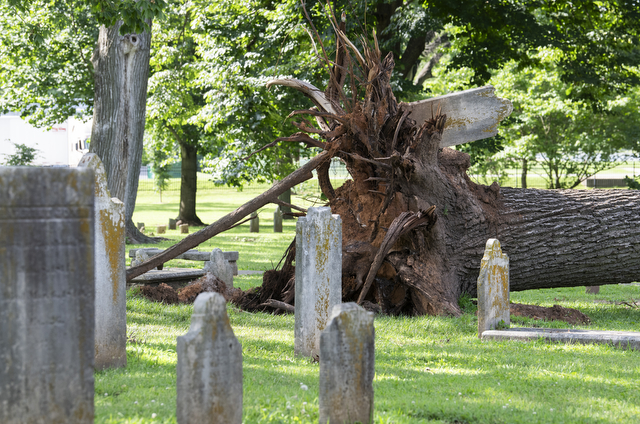Historic Logan County
Published 12:00 am Saturday, September 22, 2001
Some of Kentuckys most significant historic sights are nestled away in Logan County. The rural county at one time embraced a large portion of Western Kentucky, according to The Story of Logan County by the late Edward Coffman. It was formed out of Lincoln County in 1792, and through the years gave birth wholly or in part to 28 counties including Warren, Christian, Simpson and Todd. Today, several historic sites in Logan County are open to the public. The Bibb House is just one of those sites. It was the town house of Major Richard Bibb, a Revolutionary War officer, said Jerry Wooten, a caretaker who lives on the grounds of the Bibb House and also is director of the Shaker Museum at South Union in Logan County. Bibbs palladian-style home, on the corner of 8th and Winter streets in Russellville, was built in the early 1800s, according to Wooten. In 1829, when slavery was a significant force in most southern states, Bibb freed 29 of his slaves whom he sent to Liberia on the lawn of his home. In his will, Bibb provided for the freedom of his other slaves and gave the freed men a great deal of his farm land. Its a treasure to Logan County, Wooten said of the home that is open to visitors by appointment. It wasnt just (Bibbs) home, its a memorial to Russellville. The late Agnes Davis, the last individual owner of the home, left the Bibb House to a group called Historic Russellville upon her death in the 1980s. She specified that the home she had furnished with what Wooten calls fabulous antiques, be used as a museum. The home is important to Russellvilles history for many reasons. It has a lot of ties to the early founders of Russellville, Wooten said. At the time, Bibb was one of the most significant landowners in Logan County. Bibb was also the man who developed Bibb lettuce. While Bibb was busy developing a special vegetable in Logan County, a group of indentured servants and slaves were making saddles and other leather goods in a Russellville factory that is now a museum. Brothers Andrew and David Caldwell built the saddle factory in 1817.But they werent as generous with their workers as was Bibb. The Caldwells housed 40 slaves and indentured servants, including their own cousin, who was orphaned at a young age, in a tiny attic above the saddle factory. It was mainly young boys or younger children, said J. Gran Clark, an attorney and volunteer who works with historic sites in Logan County. The factory is a place where graffiti left behind by those who lived in the attic tells a tale of lives that were far from joyous. Free, two years from this day, wrote William S.C. Caldwell, the indentured servant who was a cousin to the Caldwell brothers. Some young people worked math problems on the walls. Today, the Saddle Factory Museum showcases the original work of such young craftsmen. We call this life before Wal-Mart, Clark said as he showed saddles made in the factory in the mid-1800s.But the museum, open Fridays and Saturdays, features more than leather goods. The fish-shaped weather vane that once graced the top of the Logan County courthouse and some say was pierced by a bullet from a member of Jesse James gang is in the museum, as are items that will someday be housed in an African American Museum that is now in the planning stages. Clark thinks having such things available for the community to see is important. To me, thats the greatest thing about this, he said of the museum, which was turned into an elegant home in 1849, but is now rather rough looking because those who renovated it wanted it to be as authentic as possible. Being able to put it in perspective and realize what other people went through to make our lives more comfortable is important. Other historic sites in Logan County include:Shaker Museum at South Union. This museum houses the worlds largest collection of southern Shaker antiques. Seven buildings are now open at the museum. The buildings were once part of a village that consisted of 269 buildings on more than 6,000 acres of Shaker-owned land. The Shakers, a religious group that practiced tolerance, celibacy and the segregation of the sexes, began disappearing slowly from southcentral Kentucky after the Civil War, when an increasingly industrialized nation threatened their agrarian way of life. The group finally abandoned the village at South Union in the 1920s. Today, visitors can take tours of the Shaker Museum and stay in the Shaker Tavern, located a few miles away from the museum, seven days a week. For more information call (270) 542-4167.J. Gran Clarks law office, at 175 West Fourth St. in Russellville. A group of delegates from across Kentucky met in an upstairs room of what is now Clarks law office to vote to secede from the Union on Nov. 18, 1861. The delegates, whom the federal government did not recognize, chose Bowling Green to be the Confederate capitol of Kentucky. The building is open Monday through Friday. For more information, contact Clark at (270) 726-2085.The old Southern Bank building at 296 S. Main Street in Russellville. This is currently Clarks home, but it was once a bank that was reportedly robbed in the late 1800s by the Jesse James gang. Each fall, during the Logan County Tobacco Festival, townspeople reenact the legendary robbery. James was a relative of many people in Logan County. This home is not open to the public.






